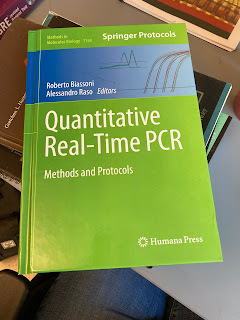Currently, we do not have cultures of Alexandrium catenalla - therefore we will try to purchase A. fundyense. This means I need to find probes for A. fundyense. I learned this morning that A. fundyense and A. tamarense are closely related, while mating compatibilities even suggest them to be varieties of a single heterothallic species.
 |
Image of A. fundyense found at: https://microbewiki.kenyon.edu/index.php/Alexandrium_fundyense_NEU2011
|
 |
Light microscope and Scanning Electron Microscopy images of Alexandrium species (Kim et al., 2017)
|
How will closely related species affect probe design?
I read yesterday that a recent study couldn't make species-specific primers for the ITS1-5.8S-ITS2 rRNA gene region for Alexandrium catenalla. This was due to high nucleotide similarilty both with A. tamarense and A. fundyense (Galluzzi et al., 2010).
Well, now I need to know the difference between ITS1-5.8S-ITS2 rRNA gene and hypervariable D1-D2 domain. The diagram below helps me visualize where the regions are located. However, why use ITS rather than D1? Vandersea et al., 2017 reviewed two decades of investigations of Alexandrium species and found molecular studies designed species-specific assays for Alexandrium commonly targeted the hypervariable region in the LSU DI-D2 domain.
 |
| Schematic representation of nuclear ribosomal DNA regions (Stockinger et al., 2010). |
Vandersea et al., 2017 developed a species-specific PCR assay for A. fundyense Group - not a TaqMan assay unfortunately - for which I am looking.
Let me try explain using these figures:
 |
TaqMan assay requires a forward and a reverse primer, as well as a reporter probe.
|
 |
Shown here is the forward and reverse primers, as well as the TaqMan probe - with a "Q" quencher. The fluorescence occurs when the "R" is removed and leaves behind the "Q."
|
Hatfield et al., 2019 used a Taqman qPCR assay to target multiple species of Alexandrium. The assay targets a 125bp region of the 18S rDNA gene and was developed by de novo alignment of 25 Alexandrium species.They noted limitations to the assay - no resolution of taxonomy beyond Genus level. This is not useful for me - I want to identify species - I cannot use this assay.
I will continue to look for primers and probes for A. fundyens. In the meantime, here are some figures I found today that show the interior of A. fundyense as well as the life cycle of A. fundyense.
 |
Figure showing the interior of Alexandrium fundyense as it is infected by the parasite
Amoebophrya (Lu et al., 2016). This is a nice drawing of the interior of the Alexandrium
fundyense cells. |
 |
| Diagram of Alexandrium life cycle found at: https://microbewiki.kenyon.edu/index.php/Alexandrium_fundyense_NEU2011 |
Galluzzi, L., Bertozzini, E., Penna, A. et al. Analysis of rRNA gene content in the Mediterranean dinoflagellate Alexandrium catenella and Alexandrium taylori: implications for the quantitative real-time PCR-based monitoring methods.
J Appl Phycol 22, 1–9 (2010). https://doi.org/10.1007/s10811-009-9411-3
Lu, Yameng & Wohlrab, Sylke & Groth, Marco & Glöckner, Gernot & Guillou, Laure & John, Uwe. (2016). Transcriptomic profiling of Alexandrium fundyense during physical interaction with or exposure to chemical signals from the parasite Amoebophrya. Molecular ecology. 10.1111/mec.13566.
Kim, Eun & LI, Zhun & Oh, Seok & Ho, Yoon & Shin, H H. (2017). Morphological identification of Alexandrium Species (Dinophyceae) from Jinhae-Masan Bay, Korea. Ocean Science Journal. 52. 1-11. 10.1007/s12601-017-0031-6.
Stockinger, H., Krüger, M. and Schüßler, A. (2010), DNA barcoding of
arbuscular mycorrhizal fungi. New Phytologist, 187: 461-474. doi:10.1111/j.1469-8137.2010.03262.x
Robert G. Hatfield, Timothy Bean, Andrew D. Turner, David N. Lees, James Lowther, Adam Lewis, Craig Baker-Austin, 2019, Development of a TaqMan qPCR assay for detection of Alexandrium spp and application to harmful algal bloom monitoring, Toxicon: X, vol. 2, https://doi.org/10.1016/j.toxcx.2019.100011.

















